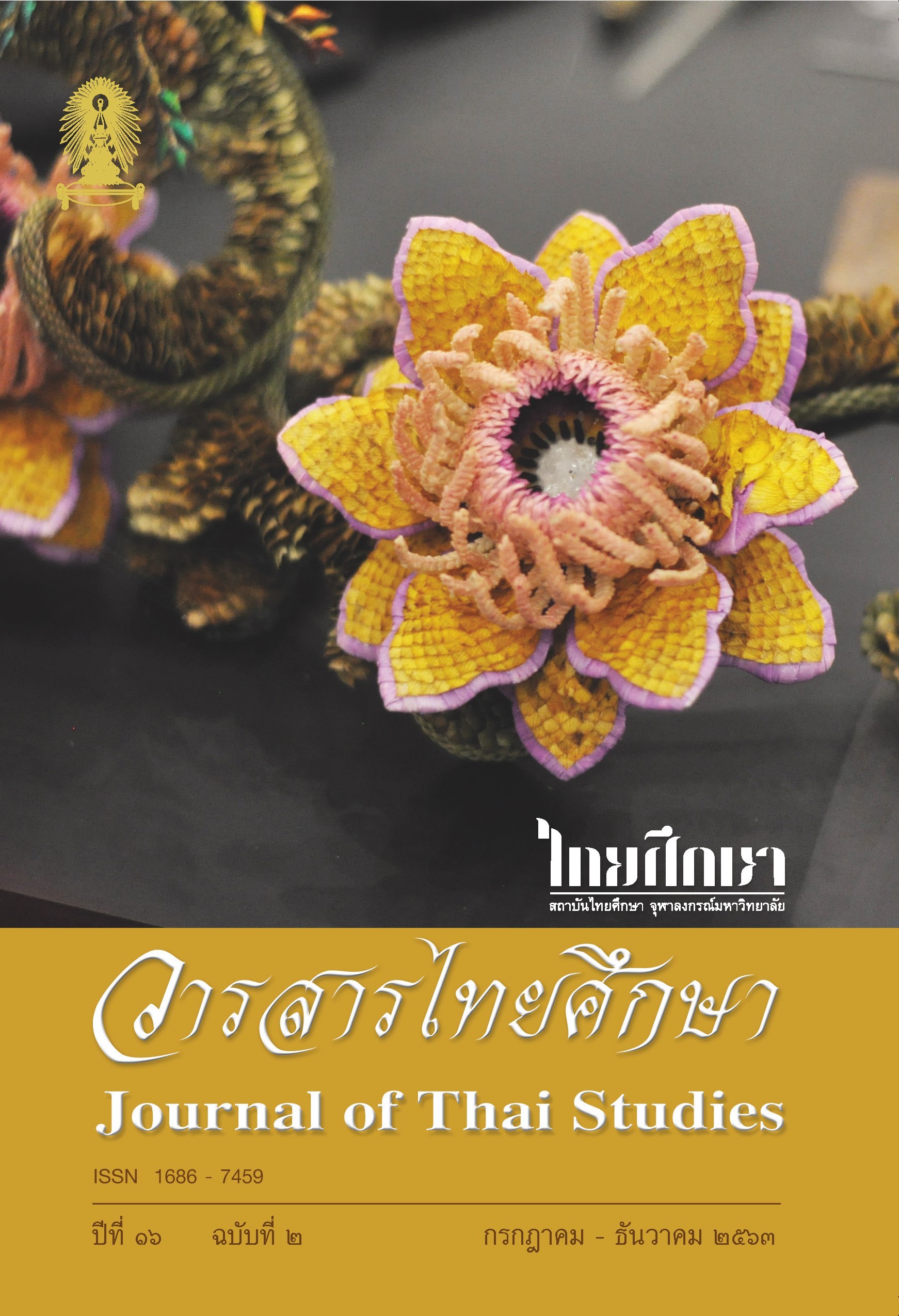“Thainess” in “CLOGS ON OUR WHEELS, OUR CLOGGED UP WHEELS, AND THE OTHER RELATED STORIES” : A study of the relationship between language and ideology
Main Article Content
Abstract
This article aims to analyze the ideological linguistic strategies in “Clogs on Our Wheels, Our Clogged up Wheels, And the Other Related Stories”, and to analyze the discourses through critical articles in the book written by Asawabhahu “Clogs on Our Wheels, Our Clogged up Wheels, And The Other Related Stories”, published in 1915 during the reign of King Rama VI. Results of the study indicated that six linguistic strategies were used to present ideology: 1) lexical selection; 2) metaphor; 3) idioms; 4) verbal irony; 5) metonymy; and 6) pseudonym. These linguistic strategies presented 13 mindsets: 1) nationality mindset; 2) monarchy mindset; 3) gender mindset, male and female; 4) state and people mindset; 5) city and rural mindset; 6) poverty mindset; 7) ethnic groups mindset; 8) senior and junior mindset; 9) democracy mindset; 10) good population mindset; 11) Buddhism mindset; 12) ‘Theirs’ and ‘Us’ mindset; and 13) parents mindset. These mindsets show three latent ideologies in the discourse: 1) monarchy; 2) nationalism; and 3) paternalism. These discourses demonstrate ideas about Thainess to make Thai people loyal to the concept of Nation, Religion and Monarch because the situation of Thailand, both inside and outside the country, was transforming into a new regime, democracy.
Downloads
Article Details

This work is licensed under a Creative Commons Attribution-NonCommercial-NoDerivatives 4.0 International License.
Journal of Thai studies is licensed under a Creative Commons Attribution-Noncommercial-NoDerivatives4.0 Intenational (CC BY-NC-ND 4.0) licence, unless otherwise stated. Plese read our Policies page for more information on Open Access, copyright and permissions.
References
Blommaert, J. (2005). Discourse. Cambridge: United Kingdom.
Bunyasathit, W. (2014). Responses of the female county social milieu to Westernization during the reigns of King Mongkut to King Vajiravudh (A.D.1851-1925). (Master dissertation). Chiang Mai University, Chiang Mai, Thailand.
Charoenthansakul, A. (1999). Cultivation of nationalism through newspapers during the reign of King Vajiravudh and Prime Minister Pibulsongkram’s government. (Master dissertation). Chulalongkorn University, Bangkok, Thailand.
Charteris-Black, J. (2005). “POLITICIANS AND RHETORIC:THEPERSUASIVE POWER OF METAPHOR”. Linguistics. pp. 762–766.
Fowler, R. (1991). Language in News. London and New York: Routledge.
Fairclough, N. (1995). “Section A : Language, ideology and power” Critical In discourse analysis: the critical study of language, (pp. 1-81) London and New York: Longman.
Fairclough, N. (1995). Media Discourse. London: Edward Arnold.
Gatkamon, M. (1974). The historical analysis of politics and administration in the reign of King Rama VI (A.D. 1910-1925). (Master dissertation). Chulalongkorn University, Bangkok, Thailand.
Hongladarom, K. (2000). Discourses on ethnic minorities in Thailand: a study of the relationship between form and meaning. Bangkok: Research report, Faculty of Arts, Chulalongkorn University.
Hymes, Dell. (1974).Toward Ethnographies of Communication. In Dell Hymes (ed). Foundations in Sociolinguistics. Philadelphia: University of Pennsylvania.
Kaewphat, S. (2016).The Relationship between Language and Representations of Isan People in National and Local Newspapers: A Critical Discourse Analysis. (Doctoral dissertation). Chulalongkorn University, Bangkok, Thailand.
Lakoff, G. and M. Johson. (1988). Metaphor we live by. Chicago: University of Chicago.
Nonthawat, C. (1990). Prawattisat Lae Kanmueang Samai Ratchakan Thi 4-7 Kon Prachathippatai Cha Ma Thueng Thima Khong Prachathippatai Kon Pit Chak Somburanayasitthira [History and politics during the reign of King Rama IV-VII before the arrival of democracy and the end of absolute monarchy] (1). Bangkok: Phabphim.
Phra Borommarajanusorn, Foundation King Rama VI. (1982). Khlon Tit Lo Khong Atsawa Phahu Lo Tit Khlon Lae Rueang Suep Nueang [Clogs on our wheels, our clogged up wheels, and the other related stories]. Bangkok: Rongphimthaikasaem.
Phamuthpisai, A. (1989). Panha Phainai Sangkhom Thai Kon Kan Patiwa 2475: Phap Sathon Chak Ngan Khian Thang Nangsuephim [Problems within Thai society before the revolution of 1932: Reflections from newspaper writings]. Bangkok: Research report, Thai Study Institute Thammasat University.
Richardson, J.E. (2007). Analysis Newspapers an Approach Critical Discourse Analysis. New York: Palgrave Macmolan.
Supanvani. I. (1999). “The language of love songs from the royal poems of King Rama VI”. Journal of Thai Language and Literature, 16(2), 109-132.
Tiwanit, S. (1988). Phrabatsomdet Phra Mongkut Klao Chaoyuhua Kap Kan Nangsuephim Thai [King Rama VI and Thai newspapers.] Bangkok: Research report, Faculty of Communication, Chulalongkorn University.
van Dijk, T.A. (2008). Introduction: Discourse and Domination. In Discourse and Power. pp. 1-27. London: Sage.
van Dijk, T.A. (2008). “Discourse and Manipulation” In Discourse and Power. pp. 211-236. London: Sage.
van Dijk, T.A. (2008). “Discourse and Racism”. In Discourse and Power. pp. 102-119. London: Sage.
van Dijk, T.A. (2003). Critical Discourse Analysis. The Handbook of Discourse Analysis., pp. 352-371. Malden, MASS and Oxford : Blackwell.
Wichit Wathakan, Luang. (1969). Ngan konkwaw ruang chonchatthai [Research on Thai nationality]. (2). Pranakorn: Kongtupbok.


